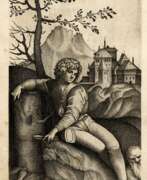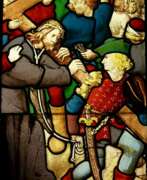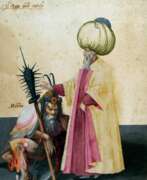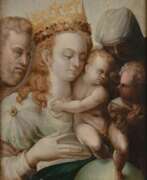Miniaturists 16th century


Abd al-Samad (also known as Hodja Abdus Samad, Abd al-Samad Shirazi) was a prominent Persian miniaturist and an influential figure in the development of the Mughal school of miniature painting. Born in Shiraz, Iran, around the early 16th century, he was initially trained in the Safavid style under Shah Tahmasp in Tabriz. His career took a significant turn when he moved to India, where he joined the court of the Mughal emperor Humayun and later served his successor, Akbar.
Abd al-Samad's impact on Mughal art was profound. He co-directed a rapidly expanding imperial atelier and was instrumental in the production of the Hamzanama, an ambitious project that consisted of 1,400 large-scale paintings. His administrative prowess was recognized by Akbar who appointed him to several high-ranking positions, including the director of the royal mint and the governor of Multan. Despite his administrative duties, Abd al-Samad continued to influence the artistic direction of the Mughal court through his teaching and his own works, which remained loyal to the Persian artistic tradition.
Several of Abd al-Samad's works are preserved in major museums, including a portrait of Akbar, which reflects his mastery and his stylistic adherence to Persian aesthetics. His works are noted for their detailed execution and the integration of Persian and Indian elements, a testament to his role in shaping the Mughal artistic heritage.
For more on Abd al-Samad's life and works, you can visit the Metropolitan Museum of Art's collection.
If you are interested in updates on exhibitions and sales related to Abd al-Samad's works, consider signing up for relevant notifications. This will keep you informed about new insights and opportunities to engage with his art at auctions and galleries.


Amico Aspertini was an Italian Renaissance painter, draughtsman, and sculptor, considered one of the leading representatives of the Bolognese school of painting.
He was trained in the family workshop and was influenced by the artists of the Ferrara school, Ercole de'Roberti, Lorenzo Costa, and Francesco Francia. He worked as a painter and sculptor, and was also an excellent draughtsman, as evidenced by his many surviving drawings and sketches. Contemporaries marveled at his complex and impulsive character and noted that he worked with both hands simultaneously.
Aspertini painted splendid portraits as well as numerous frescoes and altarpiece paintings in chapels and churches in Italy. Many of his works are eccentric and eclectic, even whimsically fantastical, his complex style anticipating Mannerism.


Giovanni Pietro Birago was an Italian painter, illuminator, and engraver for the Sforza court.
He worked from 1470 to 1513 in Brescia, Venice, and Milan, was a leading Milanese illustrator and was favored by the ducal court.


Philippe de Gueldre was a French painter, illustrator, and miniaturist from the Netherlands.
He worked on a large number of royal commissions in Paris and northern France at the turn of the 15th and 16th centuries. Philippe's style was influenced by Jean Columbus; he was characterized by wide-boned figures with round faces, long noses, and small red mouths. He makes generous use of blue and gold, burgundy and green in his palette.


Attavante degli Attavanti, also Gabriello di Vante, is the best known and most representative artist of Italian miniature painting.
Attavante's elegant, expressive style was influenced by the work of Domenico Ghirlandaio and Antonio Pollaiuolo. His first recorded work, dated 1483, is a missal created for Thomas James, bishop of the Dol-de-Bretagne. He subsequently created several manuscripts for Matthias Corvinus, King of Hungary, and the Medici family, among whom was Pope Leo X. The workshop of Attavante also produced the Jerome Bible, one of the finest bibles created during the Italian Renaissance, now in the Portuguese National Archives.


Benvenuto di Giovanni di Meo del Guasta, an Italian painter hailing from Siena, was recognized for his compelling panel paintings, frescoes, and manuscripts produced over a span of 43 years, during the Renaissance period. Born around 1436, his work life was largely based in Siena, where he was first documented as a young artist in 1453. His teacher was likely Vecchietta, with whom he collaborated on fresco decoration in Siena's baptistry. Di Giovanni married Jacopa di Tommaso da Cetona in 1466, which marked the beginning of a productive period that saw the creation of notable works such as the Annunciation and Saints (1466) and the Nativity (1470).
Benvenuto di Giovanni's style was characterized by its noble, classical forms and bright, intensely lit, glassy consistency, influenced by his interaction with North Italian miniaturists like Liberale da Verona and Girolamo da Cremona. His works, such as the triptych from Montepertuso (1475), the Borghesi altarpiece, and the triptych in the National Gallery, London (1479), stand as masterpieces of his sharply defined and surreal world. In the later years of his career, di Giovanni was commissioned for floor designs in the Siena cathedral and miniatures for its choir books, showing a style that occasionally simplified due to collaboration with his son, Girolamo di Benvenuto, but remained distinctively his.
Significant works by Benvenuto di Giovanni include "The Adoration of the Magi" and "The Crucifixion," both showcasing his mastery in perspective and religious narrative. For collectors and experts in art and antiques interested in the evocative and historically rich works of the Renaissance, Benvenuto di Giovanni's oeuvre offers a captivating exploration of 15th-century Sienese artistry.
To stay updated on sales and auction events featuring works by Benvenuto di Giovanni, sign up for updates. This subscription ensures that enthusiasts and collectors are always informed about new opportunities to engage with the exquisite works of this renowned Renaissance artist.


Dionisius, a distinguished Russian icon painter born around 1440, emerged as a pivotal figure in the Moscow school of icon painters, particularly towards the late 15th and early 16th centuries. His work is characterized by a unique style known as Muscovite mannerism, which features elongated figures, diminutive hands and feet, and serene, peaceful faces. Dionisius's artistry is most notably encapsulated in his comprehensive and best-preserved work, the fresco painting of the Virgin Nativity Cathedral at the Ferapontov Monastery, which stands out for its singularly pure and gentle colors, imbuing the scenes from the life of the Virgin with a solemn and festal mood.
Throughout his career, Dionisius enjoyed the patronage of many rich and notable figures, including Joseph of Volokolamsk, who commissioned him to paint over eighty icons for various cloisters. His first significant commission was for the Cathedral of the Dormition in the Moscow Kremlin in 1481. His Crucifixion icon, created in 1500, is particularly revered and showcases a novel approach to depicting this key scene in the Christian tradition, focusing on Jesus Christ, the Blessed Virgin Mary, and John the Theologian with an emphasis on suffering and redemption.
Dionisius's legacy extends beyond his own works to include several iconic panels attributed to him, showcasing various religious figures and scenes that profoundly influenced Russian art and iconography in the centuries that followed. His depictions often featured innovative elements, such as the personified Church and Synagogue, underscoring his significant impact on the development of Russian Orthodox art.
For collectors and experts in art and antiques, Dionisius's work represents a quintessential chapter in the history of Russian iconography, offering a deep well of cultural, historical, and artistic significance. To stay informed about new discoveries and auction events related to Dionisius's work, signing up for updates can offer valuable insights and opportunities to engage with this remarkable aspect of Russian heritage.


Joris Hoefnagel or Georg Hoefnagel was a Flemish painter, printmaker, miniaturist, draftsman and merchant. He is noted for his illustrations of natural history subjects, topographical views, illuminations and mythological works. He was one of the last manuscript illuminators and made a major contribution to the development of topographical drawing. His manuscript illuminations and ornamental designs played an important role in the emergence of floral still-life painting as an independent genre in northern Europe at the end of the 16th century. The almost scientific naturalism of his botanical and animal drawings served as a model for a later generation of Netherlandish artists. Through these nature studies he also contributed to the development of natural history and he was thus a founder of proto-scientific inquiry. Hoefnagel was a very versatile artist. He is known for his landscapes, emblems, miniatures, grotesques, topographical drawings, genre scenes, and mythological and allegorical drawings and paintings. Part of Hoefnagel's artistic works was kept by Constantijn Huygens his nephew. These works were seen by Dutch artists and exercised an important influence on the development of Dutch still life and naturalist art.


Jean Pichore was a French painter, illustrator, and miniaturist.
He was one of the most famous and prolific illuminators in the production of horologers in Paris at the beginning of the 16th century. Between 1490 and 1521, he was head of a rather large workshop which carried out many orders, while he himself produced only selected works. Jean Pichore worked in many fields, including altarpiece painting, stained glass windows, tapestry designs and illuminated manuscripts.





































